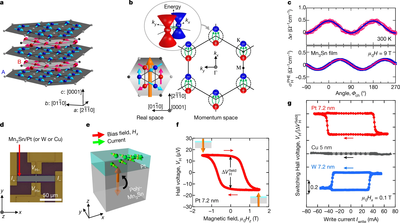Authors
Hanshen Tsai, Tomoya Higo, Kouta Kondou, Takuya Nomoto, Akito Sakai, Ayuko Kobayashi, Takafumi Nakano, Kay Yakushiji, Ryotaro Arita, Shinji Miwa,YoshiChika Otani, and Satoru Nakatsuji
Abstract
Electrical manipulation of phenomena generated by nontrivial band topology is essential for the development of next-generation technology using topological protection. A Weyl semimetal is a three-dimensional gapless system that hosts Weyl fermions as low-energy quasiparticles. It has various exotic properties, such as a large anomalous Hall effect (AHE) and chiral anomaly, which are robust owing to the topologically protected Weyl nodes. To manipulate such phenomena, a magnetic version of Weyl semimetals would be useful for controlling the locations of Weyl nodes in the Brillouin zone. Moreover, electrical manipulation of antiferromagnetic Weyl metals would facilitate the use of antiferromagnetic spintronics to realize high-density devices with ultrafast operation. However, electrical control of a Weyl metal has not yet been reported. Here we demonstrate the electrical switching of a topological antiferromagnetic state and its detection by the AHE at room temperature in a polycrystalline thin film of the antiferromagnetic Weyl metal Mn3Sn, which exhibits zero-field AHE. Using bilayer devices composed of Mn3Sn and nonmagnetic metals, we find that an electrical current density of about 1010 to 1011 amperes per square metre induces magnetic switching in the nonmagnetic metals, with a large change in Hall voltage. In addition, the current polarity along the bias field and the sign of the spin Hall angle of the nonmagnetic metals—positive for Pt, close to 0 for Cu and negative for W —determines the sign of the Hall voltage. Notably, the electrical switching in the antiferromagnet is achieved with the same protocol as that used for ferromagnetic metals. Our results may lead to further scientific and technological advances in topological magnetism and antiferromagnetic spintronics.

Nature:https://www.nature.com/articles/s41586-020-2211-2
UTokyo FOCUS:https://www.u-tokyo.ac.jp/focus/en/press/z0508_00103.html
EurekaAlert!:https://www.eurekalert.org/pub_releases/2020-04/uot-amf041420.php
AlphaGalileo:https://www.alphagalileo.org/en-gb/Item-Display/ItemId/191279
You May Also Like
These Related Stories
